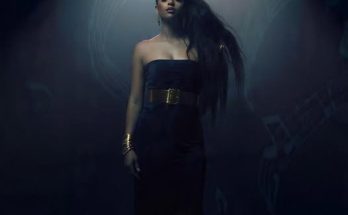Forty years ago, on October 4, 1985, the world was introduced to a sound that shimmered with quiet sophistication and effortless sensuality. Sade released “The Sweetest Taboo,” the lead single from their second studio album Promise, and unknowingly crafted one of the most timeless songs of the 1980s. At a time when pop music was dominated by bright synths, big hair, and booming drums, Sade Adu and her band delivered something entirely different—cool, smooth, and undeniably elegant. “The Sweetest Taboo” was more than just a song; it was a mood, a texture, a feeling that has outlived trends and generations. Today, four decades later, it remains one of the finest examples of musical restraint and emotional power in modern pop history.
When “The Sweetest Taboo” was first released, Sade was already on the rise. The band’s debut album, Diamond Life, had stunned the world in 1984 with its sleek fusion of jazz, soul, and pop. Songs like “Smooth Operator” and “Your Love Is King” had established Sade as the face of a new kind of cool—music that felt both cosmopolitan and intimate. Yet with “The Sweetest Taboo,” Sade took that sound even further, exploring new emotional depths while refining their sonic signature. The song opens with a soft rhythm and a wash of delicate percussion, instantly setting a tone of understated romance. Then comes Sade Adu’s voice—low, smooth, and gently hypnotic—singing of love so powerful, so rare, that it feels almost forbidden. “If I tell you / If I tell you now / Will you keep on, will you keep on loving me?” she begins, her tone both vulnerable and assured. It is a confession and a question, a whisper that feels like it’s meant only for the listener.
Musically, “The Sweetest Taboo” was striking for its minimalism. Instead of layering heavy production or chasing radio trends, the band built a subtle groove that invited the listener in rather than overwhelming them. Stuart Matthewman’s saxophone weaves gently through the arrangement, complementing the rhythm rather than competing with it. The bass line, played by Paul S. Denman, carries the entire song with quiet authority, while Andrew Hale’s keyboards fill the spaces between with warmth and color. The result is a song that breathes—open, elegant, and deeply human. It’s a masterclass in how less can indeed be more.
Lyrically, the song explores the theme of love that feels too good to be true, perhaps even too good to be safe. The “sweetest taboo” is that irresistible pull toward someone who makes you feel more alive than ever before, even if the intensity of that feeling frightens you. There’s a tension in the lyrics between surrender and caution, between the ecstasy of connection and the fear of losing control. Sade delivers these ideas not with drama or theatrics but with grace. Her voice conveys an honesty that feels almost conversational, as though she’s letting you into her private thoughts. This intimacy has always been Sade’s greatest strength—her ability to make you feel like she’s singing only to you, late at night, in a room lit by soft light.
When it was released, “The Sweetest Taboo” didn’t explode onto the charts instantly, but it grew steadily, carried by word of mouth and the band’s growing reputation. In the United States, it became one of Sade’s biggest hits, reaching number five on the Billboard Hot 100 and spending over six months on the chart. It also topped the Billboard Adult Contemporary chart, a fitting reflection of its sophisticated appeal. Around the world, from Europe to Japan, the song found an audience that appreciated its refined sensuality. It wasn’t just popular music—it was lifestyle music. People played it over dinner, during long drives, or in quiet moments when words weren’t enough. “The Sweetest Taboo” became the soundtrack of affection, intimacy, and emotional honesty.
The song’s music video, directed by Brian Ward, matched its tone perfectly. Set against wide landscapes and warm, dusky colors, the video captured the spirit of freedom and longing that the song evokes. Sade, as always, was effortlessly poised, her natural beauty and serene presence reinforcing her image as a modern-day icon of grace. She didn’t need to dance wildly or pose provocatively; her stillness was powerful enough. In a decade defined by excess, Sade stood as a quiet revolution. She made mystery magnetic again.
Forty years later, “The Sweetest Taboo” still feels fresh. Its production, though unmistakably from the 1980s, has aged far better than many of its contemporaries. The balance of organic instruments and subtle electronic touches remains timeless. Modern artists continue to draw inspiration from Sade’s style, from Beyoncé’s soulful restraint to Drake’s atmospheric melancholy. The influence of “The Sweetest Taboo” can be heard in the smooth grooves of neo-soul, the hazy textures of chillwave, and even in today’s R&B ballads that prize mood over volume. Sade’s ability to fuse emotion and elegance into a single sound changed what pop music could be.
But the song’s endurance isn’t just about musical craftsmanship—it’s about emotional truth. Every generation rediscovers “The Sweetest Taboo” because its message never loses relevance. Love, vulnerability, and the intoxicating risk of giving yourself to another person are feelings that never fade with time. There’s something deeply human about how Sade captures that mixture of pleasure and danger. When she sings “That’s why I’m giving you the sweetest taboo / That’s why I’m in love with you,” it’s not just romance—it’s surrender. It’s the sound of someone letting go of fear, even if only for a moment.
Sade’s artistry has always existed outside of trends, and that’s part of why “The Sweetest Taboo” still resonates. The band’s refusal to chase fame or commercial formulas allowed their music to breathe freely. Over the decades, Sade has released only a handful of albums, each one carefully crafted, each one an event. The band’s second album, Promise, which featured “The Sweetest Taboo,” went on to become a massive success, solidifying Sade’s place in music history. It topped charts around the world and won critical acclaim for its emotional depth and sonic coherence. Yet, despite the accolades, Sade remained elusive, avoiding the spotlight and letting the music speak for itself. That quiet dignity has become part of her legend.



